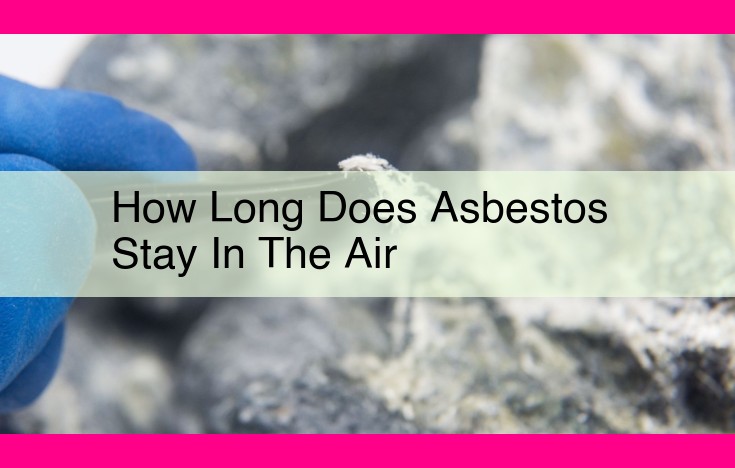Asbestos Fibers In The Air: Factors Affecting Airborne Persistence And Health Risks

Asbestos fibers, released into the air during construction, demolition, or natural events, can remain airborne for varying durations. Factors such as air movement, temperature, and particle size influence their persistence. In calm conditions, larger fibers can settle within hours, while smaller ones may remain suspended for days or even weeks, posing potential health risks to those exposed through inhalation.
Airborne Asbestos Fibers: A Silent Danger in Our Midst
Asbestos, a naturally occurring mineral, once hailed as a wonder material for its fire-resistant and insulating properties, now casts a long shadow of concern over our health due to its microscopic fibers. These fibers, when suspended in the air, become invisible and insidious, posing a significant threat to our well-being.
Definition and Characteristics of Asbestos Fibers
Asbestos fibers, composed of several silicate minerals, are remarkably thin, durable, and heat-resistant. Unlike many other airborne particles, these fibers do not dissolve in water and do not biodegrade. They can persist in the environment for decades, posing a constant threat to human health.
Their Presence in the Air and Potential Sources
Asbestos fibers are released into the air when asbestos-containing materials are disturbed or broken down. Common sources include:
- Old здания
- Insulation
- Fireproofing
- Brake linings
- Roofing materials
- Certain industrial processes
When these materials are handled, cut, or demolished, asbestos fibers become airborne and can be easily inhaled.
Health Risks Associated with Airborne Asbestos Fibers
Inhalation of asbestos fibers is a major public health concern as it can lead to serious and often fatal diseases. The fibers can lodge deep in the lungs, causing inflammation, scarring, and even cancer. The most commonly associated diseases are:
- Mesothelioma: A rare and aggressive cancer that affects the lining of the lungs, chest cavity, or abdomen
- Lung Cancer: Asbestos fibers can increase the risk of both squamous cell carcinoma and adenocarcinoma types of lung cancer
Factors Affecting Exposure Risks
Exposure risks to asbestos fibers depend on several factors:
- Occupation: Certain occupations, such as construction workers, miners, and shipyard workers, have higher exposure risks.
- Environmental Exposure: Living or working in areas with high levels of asbestos-containing materials increases the risk of exposure.
- Smoking: Smoking amplifies the health risks of asbestos exposure, greatly increasing the likelihood of lung cancer.
Health Risks of Asbestos Fibers
Asbestos, a naturally occurring mineral, has been widely used in construction and other industries. However, its exposure poses significant health risks due to the presence of microscopic fibers that can become airborne.
When inhaled, asbestos fibers can lodge in the lungs, causing damage and inflammation. Prolonged exposure can lead to a range of serious diseases, including:
Mesothelioma
Mesothelioma is a rare and aggressive form of cancer that affects the lining of the lungs (pleura) or abdomen (peritoneum). Asbestos fibers are the primary cause of mesothelioma, and exposure is the only known risk factor.
Lung Cancer
Asbestos fibers can increase the risk of lung cancer, particularly in individuals who smoke. The combination of asbestos and cigarette smoke multiplies the risk of developing lung cancer.
Other Diseases
Exposure to asbestos fibers can also cause other conditions, such as asbestosis (lung scarring) and pulmonary fibrosis (thickening and scarring of the lung tissue).
Factors Affecting Exposure Risks
Exposure to asbestos fibers can occur in both occupational and environmental settings. Occupations involving asbestos handling and construction are at particularly high risk. Environmental exposure can occur through contact with asbestos-containing materials, such as insulation or roofing, in buildings or outdoor areas.
The duration and intensity of exposure significantly influence the risk of developing asbestos-related diseases. Individuals who work with asbestos for extended periods or live in environments with high asbestos levels face greater risks.
Mitigation and Regulation of Airborne Asbestos Fibers
Organizations Responsible for Asbestos Management
Protecting public health from the dangers of asbestos requires a collaborative effort from a variety of entities. Government agencies enforce regulations, establish guidelines, and monitor compliance. Industry associations promote responsible use and disposal of asbestos-containing materials, providing guidance and training to their members. Research institutions conduct studies and develop new technologies to better understand and control asbestos hazards.
Control Measures to Minimize Exposure
Mitigating asbestos exposure is crucial to safeguard health. Engineering controls like ventilation systems remove asbestos fibers from the air, while personal protective equipment (PPE), such as respirators and suits, protects workers who must handle hazardous materials. Safe work practices further minimize exposure, such as using wet methods to prevent dust formation and following proper disposal procedures.
Regulations
Stringent regulations are in place to control asbestos use and protect workers and the public. The Occupational Safety and Health Administration (OSHA) sets strict exposure limits and mandates specific engineering controls and worker training for industries that handle asbestos. The Environmental Protection Agency (EPA) regulates the disposal of asbestos-containing materials, outlining proper removal, transportation, and disposal procedures.
Enforcement
Ensuring compliance with asbestos regulations is essential for maintaining public health. Regulatory agencies conduct inspections, investigate violations, and impose penalties when necessary. Industry associations support this effort by encouraging their members to adhere to best practices and reporting non-compliance.
Continuous Monitoring
The battle against asbestos exposure is ongoing, requiring continuous monitoring and improvement. Research institutions play a vital role in staying abreast of scientific advancements, developing new control technologies, and assessing the effectiveness of existing regulations. By staying informed and vigilant, we can strive to eliminate the dangers associated with airborne asbestos fibers.